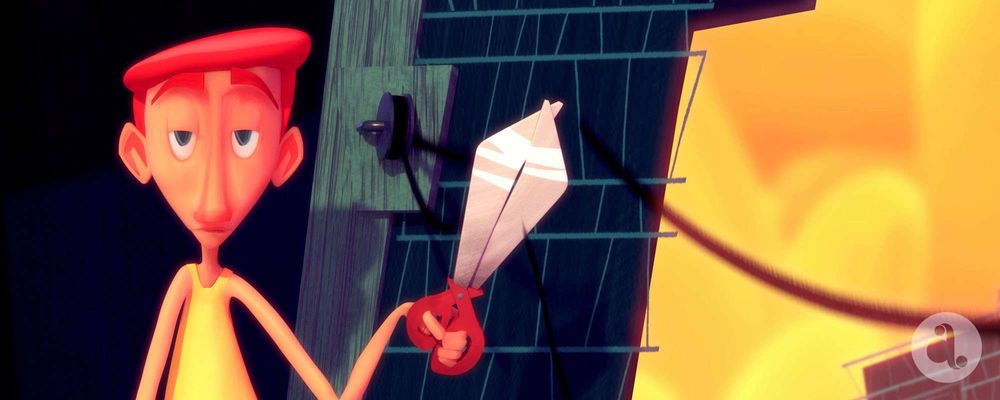
Directing an animated short is the ultimate chance bring doodles to life, and to solve a lot of creative problems along the way. For my master's thesis in Bournemouth University's MA 3D Computer Animation program I directed "Hand Wash, Line Dry", a fifties inspired animated short about a sassy bird named Dottie and an unimpressed high-rise flat tenant named Don.
The short is truly the end result of binge-watching too many 50’s cartoons, and then being set loose in a graduate animation studio. And it was a blast.
Look-Development
With an animation background rooted in design, it was important to me that every frame of my short be able to stand on its own.
I didn’t think in terms of 25 frames per second, but rather 25 illustrations per second.
A goldmine for fifties cartoon design and illustration, I turned to the pages of Amid Amidi’s ‘Cartoon Modern’ for inspiration. Bold shapes, limited color palettes, and expressive linework gave mid-century modern design the characteristic feel I was looking for. With this in mind, I moved into concept art and look-development.
The look-development phase was critical in making sure my short kept a strong fifties-inspired look while taking advantage of all that 3D animation and rendering had to offer. I wanted this animation to feel like Hanna-Barbera had been given a Maya license and told, ‘Go nuts.’



Modeling & Surfacing
Simplifying these characters down to bold shapes and colors was a priority. Don’s character is made of elongated, angular shapes, while Dottie’s sassy personality comes across in her squishy bowling pin shape and fuschia feathers. Anywhere Don has a hard angle, Dottie sports a curve. All modeling was handled in Maya.

To achieve painterly textures, texturing was carried out exclusively in Photoshop with rough, sketchy brush sets.
Rigging
The rigging process for both Don and Dottie was accelerated with the help of the Advanced Skeleton AutoRig. Each rig was then customized to fit the physical and animation requirements of each character.
Squash and stretch was a must-have for expressive character animation, so both characters had custom facial lattices added to their rigs to aid in sufficiently squishy performances.
The extreme ovular shape of both characters’ eyes also relied on lattices to allow for easy eye rotation and rigging.

In keeping with the shape language on set, rigging for environmental elements was approached with stylization in mind. While cloth simulations would be a typical first choice for clotheslines and hanging articles of clothing, wire deformers and IK splines worked well for achieving stylized shapes and art directable movement.
Animation
The goal of the animation was to emphasize performance, silhouette, and character. I referenced endless hours of Looney Tunes in attempts to create a classic ‘Wile E. Coyote vs. Roadrunner’ relationship between Don and Dottie.
Dottie’s animations were springy, stretchy, and bouncy, while Don’s were much more subtle, with long moving holds and small gestures.
Lighting
References for lighting were pulled from a variety of sources, including ‘The Peanuts Movie’, ‘Paperman’, and ‘The Lego Movie’. Each of these films managed to bridge two inherently different mediums, and I found lighting design to have played a major role in the visual identity of each film.
Studying these references, I was certain that I wanted strong saturation in my light and shadows. I was also aware that I would need to take special care in lighting the set dressings throughout the short. Many of the props on the set of ‘Hand Wash, Line Dry’ were painted poly-planes and wouldn’t take to traditional lighting techniques.
Because of this, the lighting set-up for each shot had to be established early on so that matching light and shadow shapes could be hand painted onto each prop individually.

Rendering
Not only did this hand-drawn polyplane approach help solidify the short’s extremely stylized visual language, but it also came with the blessed bonus of shorter render times, a benefit that was crucial to the production timeline with this being a one-woman production.
Depicting geometry (much of which is typically render-heavy, like cloth, feathers, clouds, and brick patterns) with stylized linework was just as much a creative decision as it was a render management one
Compositing
To keep render times as manageable as reasonably possible, a limited amount of each shot came together in camera and much of the final look and feel of the short came to life in the compositing stage.
In this regard, Nuke’s LightWrap node was a lifesaver in achieving continuity between background and foreground elements, as the LightWrap node enabled color from background matte paintings to spill over the edges of rendered characters and set dressings.
Plugging additional warmer colors into this node made for distinctive pink rim lighting, and gave more dimension to the environment lighting as well.

Conclusion
‘Hand Wash, Line Dry’ was an incredible opportunity to design a short from the inside out, and to observe firsthand the inter-dependencies of departments in the animation pipeline.
Design challenges were met with the question, ‘How would Maurice Noble draw this?’, and hand-drawn linework gave each scene the organic feel it needed.
Animation challenges begged the question, ‘How would Hanna-Barbera animate this?’. Cue Don pulling a humorously large pair of scissors out from behind his back in the final scene.
While there are still shots I would approach differently, identifying a style and sticking to it is so much of what made the short a blast to work on, and a story I would tell again in a heartbeat.
